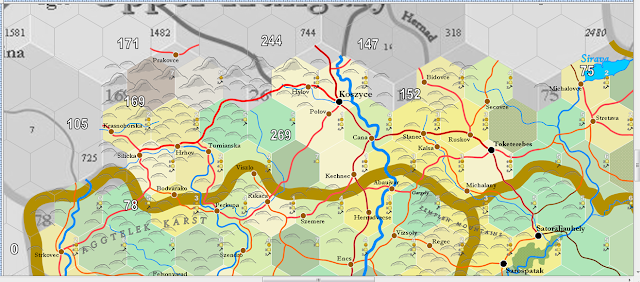As I said with the last post, this is as far north as we go for awhile:
The west side includes a spur of the Carpathians that reaches north; Lesko is in the extreme southeast of modern Poland, of which Galicia is a modern province. The province is heavily populated, more than 440 thousand. Krakow, about 140 miles WNW of Lesko, has a population of 75,000. Thus the main of the population and infrastructure is on the fat plain in west Galicia. This part is comparatively less developed. Keep an eye on that 10 infrastructure.
Presenting this as a wider shot because I've also completed the two hexes to the east, around Sambor. The 10-infrastructure hex I mentioned presented no village at all, not even a type-5 hex, so it's a collection of scattered, isolated hamlets and thorps in the hill country shown. The east side of the section was all small type-4 villages, with the exception of Lesko. Shows a definite, rustic agrarian setting. Nonetheless, it presents an important route through the Carpathians between Galicia and Upper Hungary.
The north edge of the completed part above is showing a thinning of the hills, so we're getting on the other side of the Carpathians now. This is even more evident with the completed section around Sambor, below:
The hills, called the "Low Beskids," are definitely thinning now. As we go east, geographically the area becomes the Podolian upland. This area proved disastrous for the Russians and Austrians in World War I, as the region became frozen over and the armies on both sides were bogged down fighting over the rolling terrain. The German tanks rolled easily and quickly through this country when they advanced into Russia in 1941.
We've turned the corner on the map, so it's all east from here. I'll provide a longshot without the background to provide a feeling for the method I'll follow:
The 60-degree slope is three 20-mile hexes high. The reader should note that when we walked up through Hungary, the mapping was a swath 120 miles wide, with three sections end-to-end. Now I'm only going to cut a 60-mile wide swath through Ukraine.
The main reason is that I have a great deal more east-west to create than north-south. From where we are, it's only 32 degrees latitude to the top of the world's map, where as the same number of degrees longitude east only gets us to north of the Aral Sea. It's a long, long haul around the world compared with mapping to the north or south, so the emphasis is to stretch out the map.
Out of interest, here's how much of the world I've mapped thus far:
The reader might remember that when starting the blog on November 9th, we were on a line with Budapest, so that should give a sense of what's been accomplished in just over two weeks. Thankfully, it gets easier when crossing water or getting out of the more heavily populated areas, such as Hungary and gawd help us, getting into Italy, Germany and France. That's a long way off.
Less villages means less roads, and when the hills drop away too, it's much easier to do three or four sections at a time, instead of just one. Things should skip long fairly well once we're out of Lwow County.
The sharp-eyed reader might notice that the three sections at the top don't line up in a neat 60-degree angle, like the hexes do. In fact, they're almost straight up and down. This is because the hex layout distorts and stretches the flat Earth ... something I have to compensate for constantly, stretching out rivers and mountain ranges as needed. This is one of the key reasons why making an "accurate" map is out of the question. It would slow down the process stupidly anyhow. And from the point of view of the game, the players and me, it's good. I know when I'm fudging ... the players have zero idea, because they just don't know the world as well as I do. Hell, for people who don't actually live in these spaces, or don't have a map to tell them, I imagine most would think I'm being dreadfully accurate. I'm not ... heh heh. I know it. But it doesn't matter.
As explanation, the center "empty" part of the ring of red rectangles has been done, but as I go forward I'm deleting the old sections ... google earth gets tetchy when there are too many of them. The blue rectangles are places where I had to define what was in those hexes for coastline purposes, but the actual mapping hasn't been done.
So, going forward, I'll build the bricks from the bottom up, trending slightly northwest with each line of three sections. It'll go that way until we get to the next corner. Soon enough, things start to get complicated for a completely different reason.



















































